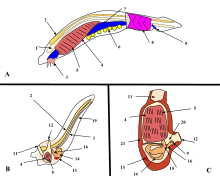Alexander Kovalevsky
Alexander Kovalevsky | |
|---|---|
University of Heidelberg | |
| Known for | Gastrulation |
| Scientific career | |
| Fields | Embryology |
Alexander Onufrievich Kovalevsky (
He was the brother of the paleontologist Vladimir Kovalevsky, and the brother-in-law of the mathematician Sofya Kovalevskaya.Discoveries

Kowalevsky's family belonged to Ukrainian nobility.
He showed that all animals go through a period of gastrulation.[1][2][3][4]
Kovalevsky discovered that
phylogeny with homologies between the germ layers of embryos, foreshadowing evolutionary developmental biology.[5]
Antoine Fortuné Marion and Alexander Kovalevsky, founder and collaborator of the Annals of Natural History Museum of Marseille
Honors
He was elected on the 1st of May 1884 a Foreign Member of the Linnean Society of London.[6] The St. Petersburg Society of Naturalists annually awards the A.O. Kovalevsky Medal.
Bibliography
- Kowalevsky, A (1901). "Les Hedylidés, étude anatomique". Zapiski Imperatorskoi Akademii Nauk. 12: 1–32.
